|
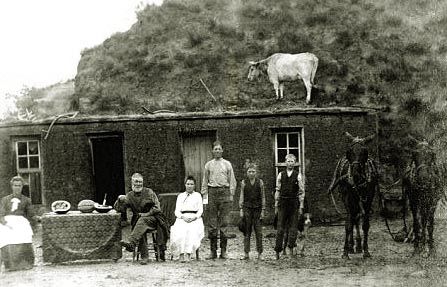
Nebraska Dugout, 1870.
A variation on the soddie was the dugout. The dugout would be excavated out of the side of
a hill and would, thus, only require that a front wall be built. Generally, dugout would be constructed facing to the
southeast so that it could catch breezes in the summer and be out of the cold winds of winter. The primary advantage of the soddie or
dugout was the cost. One Nebraskan estimated that his 1872 dugout cost $2.78, which
included lumber, $1.79; latch and hinges, $.50; stovepipe, $.30; and nails, $.39. Other advantages included
the fact that it was, similar to a soddie, cool in the summer and easier to heat in the winter. On the Great Plains it also
provided protection from cyclones and prairie fires. Due, however, to the disadvantages, the structures
were generally intended strictly as temporary quarters until after the farm or
ranch could be established and a conventional home constructed. Being temporary, they were also frequently used
as line cabins or by outlaws. The notorious Doc Middleton used a dugout in Nebrasak as a shelter while engaging in his
used horse business. Man Warner and Tom O"Day each alleged took refuge in dugouts. Reputedly Butch
Cassidy utilized dugouts near Cortez, Colorado and Manila, Utah. Horsethief Canyon north of Rock Springs has
a dugout.
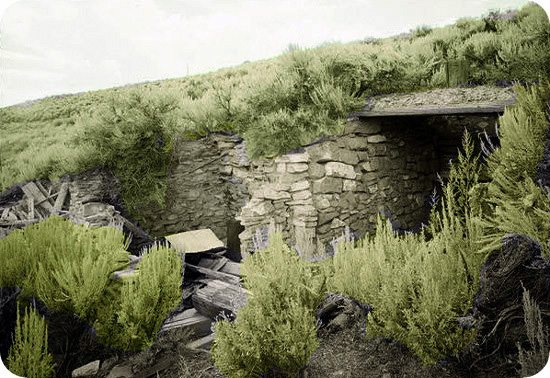
dugout in Horsethief Canyon, Wyoming
Horse Thief Canyon allegedly took its name because of its use by horse thieves. In 1893 a writer for the
Rock Creek Miner, with several others, ventured into the canyon. He noted the presence of a ruined cabin
which had previously been used by horse rustlers. He wrote that the only access to the canyon was on horseback and that a guide was
needed. Who built the above depicted dugout is most likely unknown.
In the instance of the
dugout, another disadvantage was that being underground, as depicted in the first image above, cattle might wander on to the roof, or a passing traveller
might pass right over it. One Vernon, Texas livery owner told a writer for Scribner's that he drove over
one, wondering why the ground was so uneven, until the owner confronted him with
a Winchester. Another Texas homesteader, John Gresham Harden (1854-1937) shortly before his death
recounted that when he moved to northern Clay County, Texas, now part of Wichita County, he constructed a dugout to live in while
he established his ranch. The dugout lacked, however, a door. One of those howling North Texas blizzards blew in. Harden explained,
"A good cattleman takes care of his cattle, so I spread a wagon sheet over the doorway and went to work on a
shed for the cattle just outside the shack. This was soon covered with snow but it was a break from the wind."
After finishing with the cowshed, he went back into the dugout to get warm. "In the shed the mules got to
fighting for a good warm place, crowding out the cows. * * * * But one old
cow just couln't take it. She broke out and ran across the prarie.
That was bad enough in such weather as that, but when she chose her path across the dugout entrance it was just too bad for everone
concerned.
"Talk about unexpected company dropping in! Well there she was, wagon sheet, snow, and all. Of course we all hollered. That scared her and way she want out of the dugout, scampering away over the prarie
again with the wagon sheet on her horns. Provoked as I was I had to laugh as I chased that fool cow."
Hardin only lived in the dugout for two years. He developed his ranch into a multi-thousand acre ranch on which oil was discovered. He became a
multi-millionaire and president of two banks.
In Texas, dugouts there were other unwelcome guests. East of the Pecos there were rattlesnakes. west of the Pecos,
scorpions and tarantulas liked to move in. In Texas, Oklahoma, and New Mexico, a common variation on the dugout was the
"half-dugout," a structure dug into the ground, but having short walls with a conventional roof of
shingles, sod, or thatch.
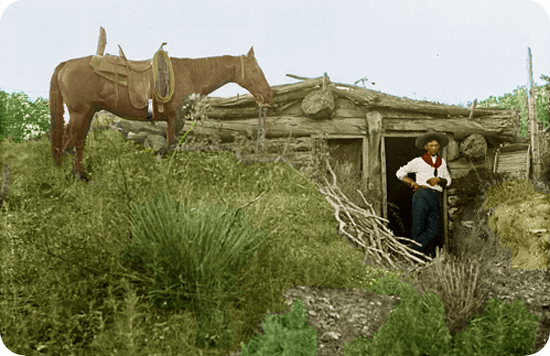
Cowboy Photographer Erwin E. Smith in door of Lee-Scott Cattle Company line camp Half-Dugout, upper Texas Panhandle, 1908. Since
Smith is in the doorway, the photo was probably taken by George Pattullo. See Pattullo, George: "Glimpses of
Cowboy Life in Texas," Photo-Era Magazine, June 1908, p. 288.
The above line camp was allegedly the first headquarters for the cattle company. A number of other
cattle companies used dugouts for initial headquarters including the Matador, the RO, the LIT, and a predecessor of the Mill Iron.
The Lee-Scott Cattle Company spread out over four counties in Texas and New Mexico along the
Canadian. The company also maintained a unit in Montana near the Yellowstone. In 1886, the company trailed
some 3,000 head to Montana. The drive required 300 saddle horses for 40 men. Earlier that year, four
L S cowboys were killed in the "Big Fight" in Tascosa. See Lusk.
On the plains, generally the half-dugout would be five to seven feet deep and eight or ten feet wide.
The walls above ground notmally would be about two feet high allowing windows for light and ventilation; these were closed with either shutters or sashes.
The L S was famed for having introduced Angus cattle west of the Mississippi. For a short period it had a unit near the
Yellowstone River in Montana.
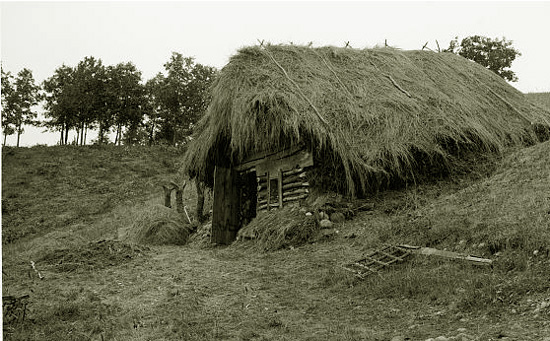
Remains of thatch-roofed half-dugout in Minnesota, approx 1898. Photo by William Henry Jackson.
Dugouts were generally found west of the area in which soddies were common. Possibly becasue of the presence of the greater
availability of stone and wood which was generally needed to support the walls and roof of the structure..
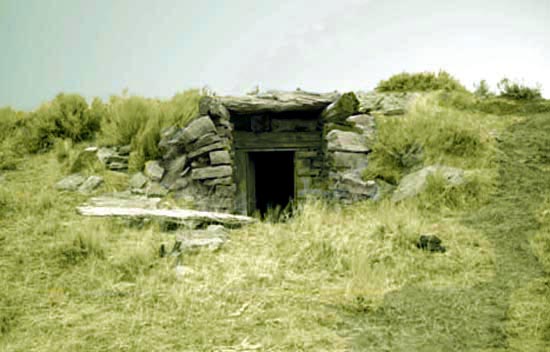
Thornburgh Dugout, 15 miles southeast of Wright, Campbell County, Wyoming.
The above dugout was apparently
constructed by Jack Thornburgh in the early 1920's
Because of the remains of a privy nearby, it is believed that it was used as a place of
residence for a short while.
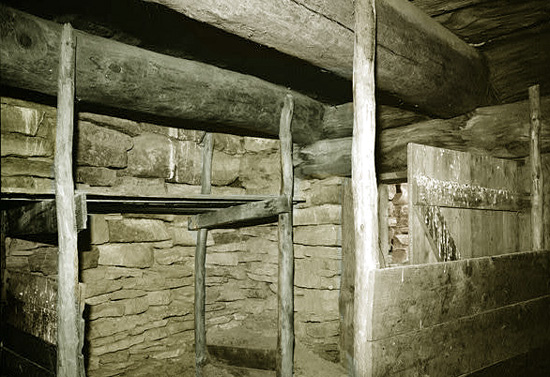
Interior Thornburgh Dugout, Campbell County.
Examples constructed of stone continue to
exist, often used as root cellars. Soddies, however, unless protected by a shingled roof and plaster, erode away.
and rarly last more than several years.
Music on this Page, Home on the Range, the words of which were written by
Dr. Brewster M. Higley when he lived in a dugout in Kansas. For more on Home on the Range, see
Briney
Next page: Oil Camps
|